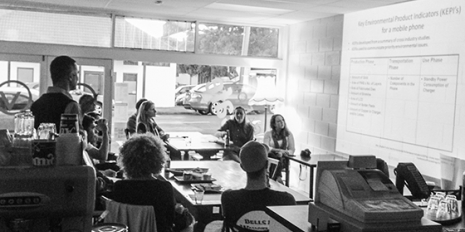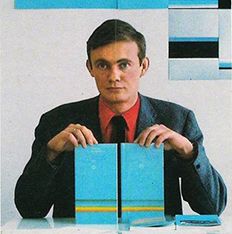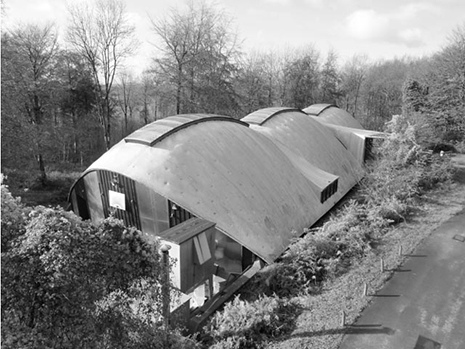
After throwing a couple of Inspiration Sessions out we brought this one closer to home – physically and philosophically. The new Vagabond Café below the Locus Studio hosted Jake McLaren talking about his journey from product design to sustainability via Nokia, Formway, and his current role as Environmental Consultant at PE INTERNATIONAL.
The Campaigner
Jake was a self-confessed activist who grew up in the UK during the Thatcher reign in the 80s which was prime time for social justice campaigning in a society of tension, miner’s strikes, and threat of nuclear war. An early inspiration was E. F. Schumacher’s book Small is Beautiful, which, in a retort to the idea that ‘bigger is better’, the idea of economies built around people, not financial growth, is explored. The philosophy of Buddhist economics and sustainable development resonated with Jake’s outlook at the time. A later job at the University of Surrey in the UK researching dynamic LCA modelling of recycling systems slotted him next to Tim Jackson, the eminent ecological economist and author of Prosperity Without Growth: Economics for a finite planet. Jackson proved to be someone who inspired Jake to grow his passion in environmental practise – see his great TED Talk.
Artistic Roots
Born into an artistic family (his father Ian McLaren was on the design team for the 1972 Munich Olympics posters), Jake’s appreciation for natural materials and how they can be processed into products were catalyzed during time at Hooke Park College in Dorset, Southern England where Jake did a short design and make course in the early years. Developed in the 80s as a college to teach and research new ways of using wood in furniture and construction, three prototype buildings were designed by leading architects, included the German master Frei Otto, to demonstrate the pioneering use of locally sourced wood. Jake pointed out it was the use of roundwood like bamboo (constructed under tension and compression) that proved new possibilities for natural and sustainable materials.

Jake's father, Ian McLaren (source)

Hooke Park Buildings (source)
Hidden Rucksacks
After a Product Design degree at Glasgow School of Art and a Masters of Design Management and Innovation at Brunel University Jake said he followed his nose from pure design to the emerging field of sustainability and environmental management.
In 2000 Jake joined the mobile phone giant Nokia in the inaugural environmental team. This was the heyday when the Finnish company was valued at a staggering €300B. Sitting within the Nokia R&D teams, the environmental team had the mandate to investigate and lower the ecological impact of the booming technology business. One of the most significant technology disruptions the world had seen presented the planet with a new scale of ecological challenges. Coined ‘hidden rucksacks’ because of the additional environmental impact a product bears beyond its physical mass, the environmental risk of mobile phones was the new elephant in the room. As the biggest technology business at the time, Nokia were the centre of attention and were inevitably connected to far-reaching problems like gorillas (and guerrillas) in the Congo. The ethics of their raw material supply chain was criticised as the precious metals used widely in phones (tin, gold, tungsten, etc) were linked to the raging civil war in the Congo.
Nokia were unique for their scale. Their environmental sensitivities were being led from the top but Jake pointed out that true success requires a mirrored bottom up effort from all staff – “sustainability has to be integrated”.

Nokia ranks on the Greenpeace scale (source)
KEPIs
Around 2004 the EU Commission’s Integrated Product Policy (IPP) initiative brought together a number of key stakeholders with the aim to reduce environmental impacts of product. Groups including Nokia, Motorola, Vodafone, WWF, and Intel came together to pilot the project with a focus on the mobile phone. “When everyone came together it was obvious that we all shared the same problems,” Jake said, “the IPP was a great example of shared learning and openness.”
One of the most powerful tools to be developed by Jake and the Nokia environmental team within the IPP is the idea of Key Environmental Performance Indicators (KEPIs). The simplified approach to environmental assessment identified a range of physical and chemical parameters through the mobile phone lifecycle and translated these into targets for reduction during the product development phase (the phase where most impact is embodied). The success of KEPIs came from the translation of these previously complex parameters into rationale targets for engineers. Production KEPIs included the amount of gold, copper, bromine, area of LCD, and printed wiring board. In transportation the target was boiled down to number of components in the phone (weight) and use was focussed on standby power consumption of the charger. The simplified approach lowered the barriers often experienced in complex LCA; it provided clear-cut results, required low data requirements, and low calculation time. It worked.
As Global Director of Insight at Frog, Jan Chipchase, points out in his book Hidden In Plain Sight, 80% of the world’s population lives on less than $10/day but 50% own mobile phones. That’s a lot of phones and a big hidden rucksack.
Healthy Life-Chairs
In 2006 Jake left Nokia for New Zealand and a position at Formway Furniture where he was responsible for integrating a life-cycle management programme. The programme included a number of associated measures including product stewardship services (take-back at end-of-life), product eco-declarations and third party environmental product certifications. The award winning Life and Be chairs are environmental product exemplars too: high recyclable materials content, no PVC, and compliant with a string of environmental certifications. All contributing to the commercial success of Formway, as office equipment is increasingly specified on these emerging e-standards; proof that sustainable design adds to the bottom line.
Helping Companies Talk
Jake now operates as an Environmental Consultant for PE INTERNATIONAL, advising global companies in sustainable strategies, implementation of environmental programmes and life-cycle assessment. Jake says his work gets businesses into the position so “they can start to talk” about their environmental credentials. He talked about business’s fear of the unknown, where environmental performance is the unknown (good or bad). The risk aversion nature of business means they need the analytical confirmation from experts like Jake so they can talk about sustainability. It’s risk management for a lot of business and unfortunately a good outcome isn’t always enough for them to talk about it.
Communication was a theme and key for success: top down communication to drive the culture, communication within development teams to create change (KEPIs) and communication to consumers with purchasing power (see Patagonia).
Looking at Jake’s background, it was apparent that his intrigue of the mechanical behaviour of materials (roundwood at Hooke Park, Hytrel at Formway) developed into a deeper understanding of materials through the environmental sciences. The design training and environmental practice provided the skills and background to translate the science requirements into design engineering speak. That is incredibly powerful.
Thanks for a reminder of purpose and responsibility Jake – cracker Inspiration Session.
Comments
Post new comment